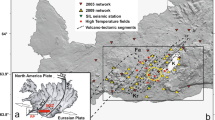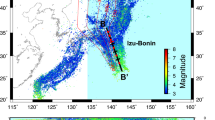Abstract
We examined the spatial distribution of intermediate-depth earthquakes in southern Alaska and the adjacent Aleutian Islands in relation to the deep fluid regime and volcanism. The distribution of earthquake hypocenters is studied in two variables, the depth of focus and the distance from the top of the slab. This approach shows that seismic activity is concentrated at 10–15 and 20–25 km from the top of the downgoing plate. Clusters of seismicity such as these cannot be due to slippage along the boundary between the continental block and the slab. In addition, extended structures of sharply increased seismic activity were found. Their location fits certain quasi-linear relations between pressure and temperature, and can mark metamorphic fronts in the subducted plate. Besides, the spatial earthquake distribution has a peak that appears to be related to active recent volcanism. It can be caused by active dehydration reactions in the subduction plate. These empirical findings testify in favor of the fluid-metamorphic model of earthquakes origin.






Similar content being viewed by others
REFERENCES
Abers, G.A., Hydrated subducted crust at 100–250 km depth, Earth Planet. Sci. Lett., 2000, vol. 176, nos. 3–4, pp. 323–330.
Cole, R.B. and Stewart, B.W., Continental margin volcanism at sites of spreading ridge subduction: examples from southern Alaska and western California, Tectonophysics, 2009, vol. 464, nos. 1–4, pp. 118–136.
Davies, J.H., The role of hydraulic fractures and intermediate-depth earthquakes in generating subduction-zone magmatism, Nature, 1999, vol. 398, no. 6723, pp. 142–145.
Fliedner, M.M. and Klemperer, S.L., Crustal structure transition from oceanic arc to continental arc, eastern Aleutian Islands and Alaska Peninsula, Earth Planet. Sci. Lett., 2000, vol. 179, nos. 3–4, pp. 567–579.
Gutscher, M.A. and Peacock, S.M., Thermal models of flat subduction and the rupture zone of great subduction earthquakes, J. Geophys. Res.: Solid Earth, 2003, vol. 108, no. B1, pp. ESE 2-1–ESE 2-16.
Hacker, B.R., Peacock, S.M., Abers, G.A., and Holloway, S.D., Subduction factory 2. Are intermediate-depth earthquakes in subducting slabs linked to metamorphic dehydration reactions?, J. Geophys. Res.: Solid Earth, 2003, vol. 108, no. B1, pp. ESE 11-1–ESE 11-16.
Hayes, G.P., Moore, G.L., Portner, D.E., Hearne, M., Flamme, H., Furtney, M., and Smoczyk, G.M., Slab2: a comprehensive subduction zone geometry model, Science, 2018, vol. 362, no. 6410, pp. 58–61.
Kalinin, V.A. and Rodkin, M.V., Physical model of deep-focus earthquakes, Izv. Akad. Nauk SSSR,Fiz. Zemli, 1982, vol. 8, pp. 3–12.
Kalinin, V.A. and Rodkin, M.V., On relation of motions orientations in the centers of deep-focus earthquakes with Benioff zones morphology, Izv. Akad. Nauk SSSR,Fiz. Zemli, 1986, vol. 1, pp. 3–11.
Kalinin, V.A. and Rodkin, M.V., The quantitative deep earthquakes model, in High Pressure Investigations in Geosciences, Berlin: Academie-Verlag, 1989, pp. 213–217.
Kalinin, V.A., Rodkin, M.V., and Tomashevskaya, I.S., Geodinamicheskie effekty fiziko-khimicheskikh prevrashchenii v tverdoi srede (Geodynamic Effects of Physical and Chemical Transformations in the Solid Medium), Moscow: Nauka, 1989.
Kirby, S., Engdahl, R.E., and Denlinger, R., Intermediate-depth intraslab earthquakes and arc volcanism as physical expressions of crustal and uppermost mantle metamorphism in subducting slabs, in Subduction: Top to Bottom,vol. 96, Kent, United Kingdom: ATLANTIC BOOKS, 1996, pp. 195–214.
Kuz’min, M.I., Khlebopros, R.G., Didenko, A.N., Kozlova, S.G., and Zakhvataev, V.E., A possible relationship between deep earthquakes and the structural transition of submolecular SiO2 fragments in rocks of a subducting oceanic slab, Russ. Geol. Geophys., 2019, vol. 60, no. 3, pp. 241–253.
Martin-Short, R., Allen, R., Bastow, I.D., Porritt, R.W., and Miller, M.S., Seismic imaging of the Alaska subduction zone: Implications for slab geometry and volcanism, Geochem. Geophys. Geosyst., 2018, vol. 19, no. 11, pp. 4541–4560.
Miyamura, S., Seismicity of the Earth, in The Earth’s Crust and Upper Mantle,vol. 13, New York: AGU, 1969, pp. 115–124.
Nikitina, M.A. and Rodkin, M.V., Intermediate-depth earthquakes and the connection of the seismicity with metamorphism and deep fluid regime in subduction zone for the North Island of New Zealand, Geosist.Perekhodnykh Zon, 2020, vol. 4, no. 1. pp. 103–115.
Okazaki, K. and Hirth, G., Dehydration of lawsonite could directly trigger earthquakes in subducting oceanic crust, Nature, 2016, vol. 530, no. 7588, pp. 81–84.
Oleskevich, D.A., Hyndman, R.D., and Wang, K., The updip and downdip limits to great subduction earthquakes: Thermal and structural models of Cascadia, south Alaska, SW Japan, and Chile, J. Geophys. Res.: Solid Earth, 1999, vol. 104, no. B7, pp. 14965–14991.
Peacock, S.M., Thermal and petrologic structure of subduction zones, in Subduction: Top to Bottom,vol. 96, Kent, United Kingdom: ATLANTIC BOOKS, 1996, pp. 119–133.
Ponko, S.C. and Peacock, S.M., Thermal modeling of the southern Alaska subduction zone: insight into the petrology of the subducting slab and overlying mantle wedge, J. Geophys. Res.: Solid Earth, 1995, vol. 100, no. B11, pp. 22117–22128.
Rodkin, M.V., Rol’ glubinnogo flyuidnogo rezhima v geodinamike i seismotektonike (Role of Deep Fluid Regime in Geodynamics and Seismotectonics), Moscow: Nats. geofiz. komitet, 1993.
Rodkin, M.V. and Rukavishnikova, T.A., Oil-formation center as non-equilibrium dynamic system–the model and its comparison to experimental data, Geol. Nefti Gaza, 2015, vol. 3, pp. 63–68.
Rodkin, M.V. and Rundkvist, D.V., Geoflyuidogeodinamika: Prilozhenie k seismologii, tektonike, protsessam rudo- i neftegeneza (Geofluids and Geodynamics: Application to Seismology, Tectonics, Process of Ore and Oil-Genesis), Dolgoprudnyi: Intellekt, 2017.
Rodkin, M.V. and Tikhonov, I.N., The typical seismic behavior in the vicinity of a large earthquake, Phys. Chem. Earth, 2016, vol. 95, pp. 73–84.
Romanova, V.A. and Os’kina, G.N., Visualization of Kuns surface forming, Vestn. RUDN.Ser.: Inzh. Issled., 2011, vol. 4, pp. 13–18.
Rondenay, S., Abers, G.A., and van Keken, P.E., Seismic imaging of subduction zone metamorphism, Geology, 2008, vol. 36, no. 4, pp. 275–278.
Stachnik, J.C., Abers, G.A., and Christensen, D.H., Seismic attenuation and mantle wedge temperatures in the Alaska subduction zone, J. Geophys. Res.: Solid Earth, 2004, vol. 109, no. B10, paper ID B10304.
Wadati, K., Shallow and deep earthquakes, Geophys. Mag., 1928, vol. 1, no. 4, pp. 162–202.
Wiemer, S. and Benoit, J.P., Mapping the b-value anomaly at 100 km depth in the Alaska and New Zealand subduction zones, Geophys. Res. Lett., 1996, vol. 23, no. 13, pp. 1557–1560.
Yamasaki, T. and Seno, T., Double seismic zone and dehydration embrittlement of the subducting slab, J. Geophys. Res., 2003, vol. 108, no. B4, Paper ID 2212.
Yang, X., Fischer, K.M., and Abers, G.A., Seismic anisotropy beneath the Shumagin Islands segment of the Aleutian-Alaska subduction zone, J. Geophys. Res.: Solid Earth, 1995, vol. 100, no. B9, pp. 18165–18177.
Zhao, D., Christensen, D., and Pulpan, H., Tomographic imaging of the Alaska subduction zone, J. Geophys. Res.: Solid Earth, 1995, vol. 100, no. B4, pp. 6487–6504.
ACKNOWLEDGMENTS
This work was carried out as part of the state assignment of the IETP RAS (AAAA-A19-119011490129-0) and IMGG FEB RAS (topic AAAA-A18-118012290125-2.2). The study was supported in part by the Russian Foundation for Basic Research, project no. 19-05-00466.
Author information
Authors and Affiliations
Corresponding author
Rights and permissions
About this article
Cite this article
Nikitina, M.A., Rodkin, M.V. & Shmakov, I.G. Relationships of the Seismicity at the Alaska Subduction Zone to Metamorphism and the Deep Fluid Regime. Izv., Phys. Solid Earth 56, 892–899 (2020). https://doi.org/10.1134/S1069351320060063
Received:
Revised:
Accepted:
Published:
Issue Date:
DOI: https://doi.org/10.1134/S1069351320060063




